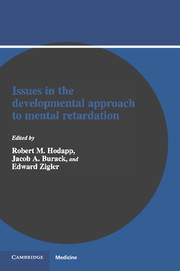Book contents
- Frontmatter
- Contents
- Preface
- Contributors
- Part 1 Developmental theory
- Part 2 Applying developmental theory to different types of retarded individuals
- 7 Cultural–familial mental retardation: A developmental perspective on cognitive performance and “helpless” behavior
- 8 The organization and coherence of developmental processes in infants and children with Down syndrome
- 9 Developmental issues in fragile X syndrome
- 10 Deviance and developmental approaches in the study of, autism
- 11 The issues of multiple pathways in the development of handicapped children
- 12 Summing up and going forward: New directions in the developmental approach to mental retardation
- Author index
- Subject index
7 - Cultural–familial mental retardation: A developmental perspective on cognitive performance and “helpless” behavior
from Part 2 - Applying developmental theory to different types of retarded individuals
Published online by Cambridge University Press: 07 September 2010
- Frontmatter
- Contents
- Preface
- Contributors
- Part 1 Developmental theory
- Part 2 Applying developmental theory to different types of retarded individuals
- 7 Cultural–familial mental retardation: A developmental perspective on cognitive performance and “helpless” behavior
- 8 The organization and coherence of developmental processes in infants and children with Down syndrome
- 9 Developmental issues in fragile X syndrome
- 10 Deviance and developmental approaches in the study of, autism
- 11 The issues of multiple pathways in the development of handicapped children
- 12 Summing up and going forward: New directions in the developmental approach to mental retardation
- Author index
- Subject index
Summary
The developmental position – to which this volume is devoted – has proven to be a theory-rich enterprise. This position is associated most directly with theories of cognitive functioning in mentally retarded persons. However, the developmental position has also stimulated a wealth of theory on the role of extracognitive (e.g., motivational and personality) factors that influence the behavior of mentally retarded people. In keeping with that tradition, this chapter will address both cognitive and extracognitive processes, delving into theory and research on how both processes may shape the observed behavior of mentally retarded people.
Cultural–familial retardation
The chapter will focus specifically on cultural-familial retardation, a condition that describes approximately 75% of all retarded people. Individuals suffering from this form of retardation have also been labeled “retarded due to psychosocial disadvantage” in an American Association on Mental Deficiency publication on classification (Grossman, 1983, p. 149).
Characteristics of cultural–familial retarded people
The cultural–familial group includes those individuals whose mental retardation does not result from specific, identifiable organic or genetic anomalies (e.g., Down syndrome or focused brain damage); excluded from the cultural–familial group are “those whose intellectual apparatus has been damaged, thus altering the biological side of the formula” (Zigler, 1987, p. 4). Accordingly, unusual physical characteristics such as those associated with Down syndrome or phenylketonuria are not likely to be present; instead, cultural–familial retarded persons tend to look very much like their nonretarded peers.
- Type
- Chapter
- Information
- Issues in the Developmental Approach to Mental Retardation , pp. 137 - 168Publisher: Cambridge University PressPrint publication year: 1990
- 9
- Cited by



